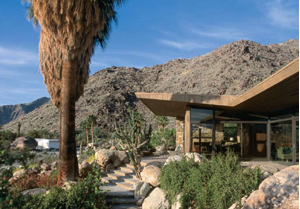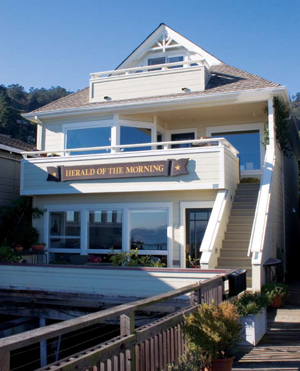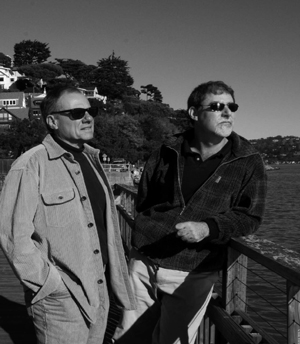Sometimes, destiny can be delayed, but never denied. Just ask Sausalito architects J. R. Roberts and John Boccardo, who specialize in architectural restoration, share a passion for midcentury modern architecture and revel in the beauty of Palm Springs.
“I love the contrast [of going] between the wet redwoods of the north and the dry, warm climate of the desert,” says Roberts, a former Sausalito mayor and city councilman from 1998 to 2002. “After it rains in the desert, the mountains explode into spectacular shows of colors from wild flowers and cactus. The air smells of sage and feels like velvet moving over your skin.”
Before they moved to Sausalito, Roberts and Boccardo lived in Palm Springs. There they noticed a stunning example of midcentury modern architecture that would ultimately become their home. In the late 1980s, says Roberts, “John and I used to drive by the house and dream of owning it.”
Located in the Little Tuscany neighborhood in the Palm Springs foothills, an area known for its privacy, boulder-strewn lots, and spectacular views, the 2,800-square-foot home on just over a half acre of land had captured their hearts. Alas, the house belonged to another. So Boccardo and Roberts bought and restored a different midcentury modern home. They never expected the phone call they received in 1999, alerting them that their dream home was about to go on the market.
“John was on a plane the next day and we bought it,” says Roberts.“I didn’t see it until we were in escrow. I didn’t need to. I knew I wanted it and was not afraid of the restoration.”
A House Built for Friendship
The home was designed and built in 1953 by the late E. Stewart Williams, of Williams, Williams and Williams, an architectural firm best known for its impressive roster of commercial projects, among them the Coachella Savings and Loan, the Palm Springs Desert Museum and the Mountaintop Station of the Palm Springs Aerial Tramway. As a residence, Roberts and Boccardo’s house was a distinctive exception, as was Frank Sinatra’s home.
“Stu did very few houses,” Roberts says of the pioneering architect. “This house was a true labor of love for him and one of his very favorite designs.” He did it only because his lifelong friends, Bill and Marjorie Edris, owners of the Olympic Hotel in Seattle, had asked him to design.

Palm Springs home is situated on a hill that allows breathtaking views from every room
When the construction estimate came in at $126,000, Marjorie Edris flinched. At a time when homes sold for about $14,000, it seemed a fortune. But her husband reportedly assuaged her sticker shock by saying, “Marge, money is for spending!”
Stories like this are among the many memories of a friendship struck between the home’s celebrated architect and its new owners. In fact, Roberts was one of only five people asked to speak at a memorial honoring Williams held last year in the museum he designed.
“He was an amazing man with great talent, dark humor and a wonderful family,” says Roberts. “He was grateful that we bought and restored the house, and we remain friends with his kids.” In fact, Roberts serves on the board of the Palm Springs Desert Museum with Williams’s daughter-in-law Sidney.
The Object of Affection
The newly purchased dream home was in a nightmarish state. After Marjorie Edris died, a couple had bought the house with the intention of gutting it and rebuilding in a Southwestern style. Instead, it sat vacant for several years.
Still, the house had “good bones.” Made almost entirely of rock, glass, steel and wood, it boasted views from every room, a ceiling of sandblasted Douglas fir, walls and doors of mahogany and walnut and a palette of desert colors. A breathtaking view of the valley magically unfolded before the living room’s 24-foot-long wall of floor-to-ceiling glass.
Armed with the home’s original plans and specifications and a set of original photographs taken by the area’s famed photographer Julius Schulman, and with access to Williams himself, Roberts and Boccardo launched a year-and-a-half-long restoration.
Only two small architectural changes, approved by Williams, were executed: removal of a built-in vanity and installation of an open spa tub where an enclosed deck had been. A bigger challenge was to find matching wood to replace the peeling wall veneers and the Douglas fir siding on the eaves, a quest in which 12 loads of wood were rejected.
While the landscaping and interior elements—built-in planters, custom lighting, and surfaces and fixtures in the kitchen and bath—were still intact, the house was bare. Authentic or style-compatible furnishings were needed to complete it.
Boccardo and Roberts found a George Nelson stereo cabinet (since adapted to accommodate a plasma television), a Florence Knoll partners desk, and a tri-leg dining table base. They also purchased newer pieces, such as corporate stack chairs from Donghia for the dining room and a B&B Italia’s “Harry” sofa, along with a pair of made-to-order chairs for the living room.
The Edris house is now designated a historic site by the city of Palm Springs, ensuring it lifelong protection.
Living the Life
Roberts and Boccardo sold their San Carlos Street home in Sausalito this year and moved into a waterfront Victorian duplex that once was the residence of former Sausalito mayor Sally Stanford. The duplex is adjacent to Stanford’s former Valhalla restaurant, which Roberts and Boccardo also own.
Dividing time between Sausalito and Palm Springs might seem unsettling, but not for these two. “When we’re in Sausalito, we’re mostly working, but when we’re down here, and in this house, we’re ‘living the life,’” Roberts says.

Their Victorian duplex was once home of former Sausalito mayor Sally Stanford
That life includes morning walks with their dog Hoover, hikes into the foothills, trips to the gym by Vespa scooter, scenic drives in either of two classic Cadillac convertibles, and designing new homes, one of which earned the Palm Springs Modern Committee’s “Best New Architecture” award.
When the sun sinks over the mountaintops and the stars start twinkling above the desert floor, Boccardo and Roberts watch as Palm Spring’s nightlife heats up. “After the workday, people get together for cocktails and dinner—and not just drinks: I mean cocktails in the old-fashioned sense of the word,” Roberts says. “The desert is very social!”
He traces the conviviality back to the glamorous heyday when the Hollywood set considered Palm Springs their playground. Here, “the stars and celebrities could let their hair down,” he says. “Frank Sinatra would run a flag up the pole to let his friends know that he was in town and the bar was open. I love that story.”
Roberts and Boccardo are dedicated to preserving the architectural heritage of Palm Springs. They admire the liberal use of glass and organic materials and the relationship between interior and exterior spaces that define the midcentury style, but they also appreciate the philosophy that propelled it.
“The 1940s and 50s was a more conservative time in America and these guys were taking big artistic risks,” Boccardo says.“We’re inspired by the pioneer spirit and freedom that the architecture and art expressed in that era.”
Through the Palm Springs Modern Committee, Roberts encourages local governments to treasure their architectural legacy and encourages them to restrict hillside developments that threaten the area’s character and views. “The payoff has been enormous in that midcentury design has come into the spotlight and is inspiring a whole new generation of architects and designers,” Roberts says.
They’re not the only ones. When Boccardo and Roberts open up their home for architectural tours and charity events, the public is inspired, too. “The Edris house has the ability to show people that not all modern homes are cold,” says Boccardo. “In fact, most people who visit say they can imagine themselves living here. That’s the ultimate compliment.”


